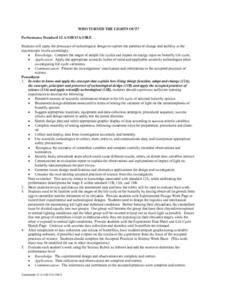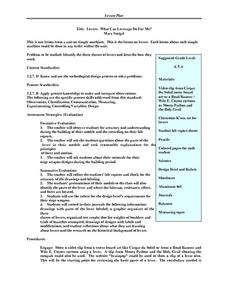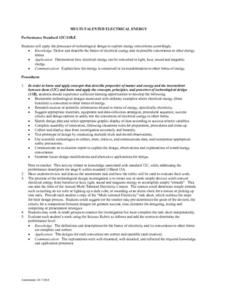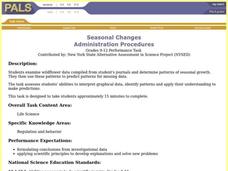Curated OER
AP Biology Lab Review
A seventy-two slide PowerPoint that reviews several lab explorations done in an AP Biology course. For each lab there is a description, concepts, and conclusions. Many pictures and graphics make this visually appealing, but it would not...
New York City Department of Education
Grade 9-10 Literacy in Science: Using DNA to Solve a Crime
Scholars become detectives and use science to solve a crime! A complete unit introduces DNA and includes hands-on activities that have learners model DNA and extract it from different food types. A culminating activity challenges...
University of Florida
Protecting Our Water Resources
Teach young environmentalists to protect their planet's resources with a set of interactive experiments. Kindergartners and other youngsters learn about watersheds and the water cycle, while older elementary learners focus on fertilizer...
Curated OER
Water Regulation
High schoolers use their basic knowledge of physiology to analyze graphical data of paramecia under diverse conditions. From the data analysis, Students develop explanations of the animal's response to the concentration of different...
Curated OER
Who Turned the Lights Out?
Students discover the life cycle of butterfly by observing its growth from egg to caterpillar and the formation of its chrysalis. Students conduct an experiment in which they design housing for the chrysalises which are either in full...
Curated OER
Traveling Through the Digestive System
Second graders learn about how the food is broken down in our bodies and the job of each body part involved in our digestive system. The utilize the CD ROM game, "Body Works." This wonderful game takes pupils through the human body's...
Curated OER
Fast Cars and Roll-Over
Students creat a ramp using cardboard and tape. They follow directions to perform an experiment to determine the degree of tilt needed to cause an empty milk carton to tip over. Students discuss their results in terms of center of gravity.
Curated OER
Levers: What Can Leverage Do For Me?
Students determine the identity of the three classes of levers while explaining how each works. They wait a video clip that shows uses for different types of levers and work as a class to write a KWL chart. Finally, they make a model fo...
Curated OER
New Creations from Six Simple Machines
Middle schoolers explore different types of simple machines and research the concepts of force, effort, and work. They conduct Internet research and complete a worksheet about examples of simple machines used in everyday life. Students...
Curated OER
Journal of the Stars
Young scholars receive balloons representing the "Life Cycle of the Stars." As the attached script is read, students follow the directions for the color of balloon they are given. Young scholars chart the results for their star. They...
Curated OER
Multi-Talented Electrical Energy
Learners explore energy conversions by demonstrating the conversion of electrical energy into light, heat, sound, and magnetic energy. Students create a simple device that converts electrical energy from batteries to heat, light, sound...
Curated OER
Clay Sculpture: Relationships
Learners explore art history by conducting an in-class activity. In this sculpting instructional activity, students examine previously created art sculptures in a textbook. Learners utilize clay, sculpting tools and grey paper to create...
Curated OER
Graphing Data from the Chemistry Laboratory
Students graph and analyze data using a spreadsheet.
Curated OER
The Captain And Lake Wilmar
Tenth graders examine the ecosystem of Lake Wilmar through three coordinated performance tasks. They first investigate the effects of pH on freshwater animals by comparing the zooplankton counts from three different areas. They then...
Curated OER
Boyle's Law
Students experiment on Boyle's law using balloons and other common materials. In this chemistry lesson, students explain the relationship between pressure and volume. They solve problems relating to Boyle's Law.
Curated OER
Exploring the Celestial Neighborhood
Ninth graders study the origin and organization of the solar system. They investigate the Earth's place in the system and how planetary motions explain natural phenomena observable from Earth.
Curated OER
Weather Proverbs
Students investigate various concepts related to weather. They conduct historical research to see how the study of weather originated and the application of the latest technologies in the field. Students summarize the information with...
Curated OER
Gravitational Factors
Students identify the forces that affect the weight of an object. In groups, they determine the proper math model which can demonstrate the attraction between two objects based on gravity. They discuss the relationship between the weight...
Curated OER
Wildlife Conservation (Senior, Science)
Twelfth graders explore wildlife and the diversity that makes up the living part of the planet Earth. The exploration part of the assignment is done on the Internet using selected web sites.
Curated OER
Seasonal Changes
Students examine wildflower data compiled from their student journals from the school year. They determine patterns of seasonal growth then use these patterns to predict patterns for missing data.
Curated OER
Greenhouse Effect
Students identify greenhouse gases. They explain why perfluorocarbons are a bad alternative to chlorofluorcarbons. They determine both the least and most influential greenhouse gases.






















